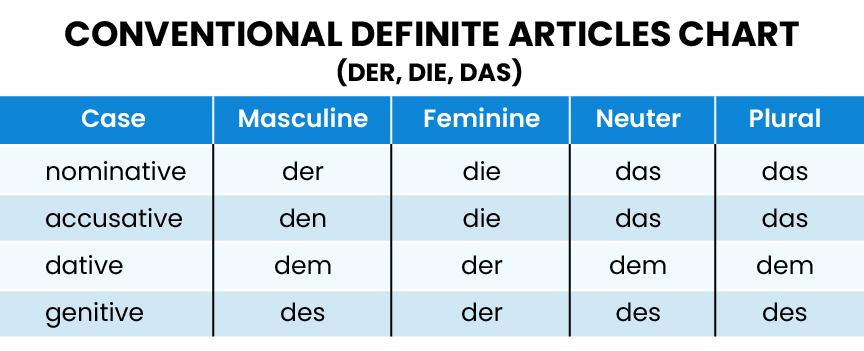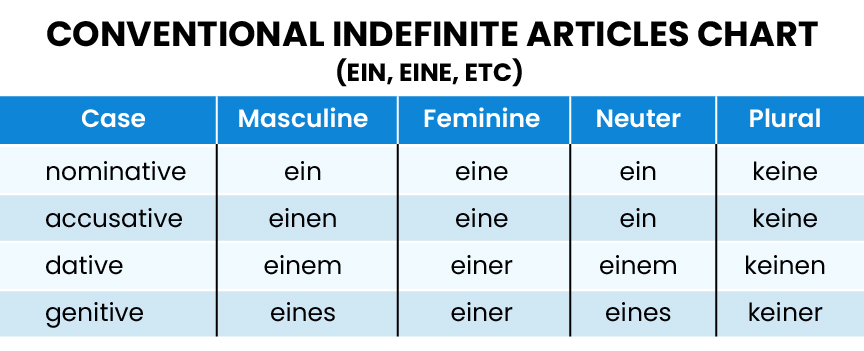Mastering the accusative case in German is key to boosting your language skills. Why is it so important? Because Accusative Case German helps you identify the direct object—the person or thing receiving the action in a sentence. It's essential for forming clear, correct sentences in German. In this guide, we'll break down the German Accusative Case with simple explanations and examples to help you learn it with ease. Let's get started!

Table of Contents
Before we explain what is Accusative Case in German, let's first talk about German Cases so that you can understand the Accusative Case better. So, there is a case system in German, which is a major part of German grammar. These case systems help us understand how pronouns, nouns, and articles change form to indicate their role in a sentence.
The German cases have four parts: the Nominative Case (Nominativ), the Accusative Case (Akkusativ), the Dative Case (Dativ), and the Genitive Case (Genitiv).
Following this, we use the Accusative Case in German to indicate the person or thing receiving the action of the verb in a sentence. In simple language, the Accusative Case shows the who or what of a sentence and helps us understand the direct object.
For example, "Die Katze fängt die Maus." (The cat catches the mouse), here "die Maus" (The mouse) is the direct object that is receiving the action. Primarily, Accusative Case German mostly affects the masculine nouns by changing their definite and indefinite articles. For example, "der" becomes "den," "ein" becomes "einen".
Now that you know what the Accusative Case is in German let's see how it works in English as well as German!
Explore Top Courses to Study in Germany
Options of a Wide Variety of Courses in germany
In English, we use Accusative Case to refer to the noun or pronoun which is a direct object of a transitive verb. To simply put it, we use the accusative form for the one who is receiving an action. Although, unlike German, the English language doesn't have separate accusative cases, it does change pronouns.
For instance, in English, "I" (nominative) becomes "me" (accusative), and "he" becomes "him." In the sentence "She saw him," "him" is in the accusative case because he is the one receiving the action. While English doesn't change the form of most nouns in such cases, it still follows the same principle—showing who or what is directly affected by the verb. Prepositions like "to" or "through" often introduce direct objects, and even though the form remains the same, the function reflects the accusative case. Grasping this concept helps us better understand how direct objects and pronouns work in both English and German.
When you learn German, the first thing you will notice is that the language uses declensions. These declensions are used to identify or indicate the role of a noun in a sentence.
Its use case is different from English because instead of showing who is doing what to whom according to the word order, in German, we change the word that comes before the noun. This is used to indicate or flag the function of the noun.
Additionally, in German, two types of words come before the noun: determiners and adjectives. So, when we use a noun in Accusative Case German, the determiners and adjectives change their form as per the noun's gender. For example, in the accusative case, the definite article "der" changes to "den" for masculine nouns.
As you know, we use Accusative cases to indicate a direct object, but there are some rules one needs to follow while using definite and indefinite articles. This will help in getting a better understanding of when to use Accusative Case in German. These include:
In the Accusative Case German, we change the definite articles like "the" based on the noun's gender. If the noun is masculine, we use "den", and if the noun is feminine, we use "die". Additionally, the neuter nouns use "das," and plural nouns use "die". Definite articles are an important part of the Accusative Case in German as it primarily affects the sentence's direct object. Here’s an Accusative Case German chart for definite articles.
Below are some Accusative Case German examples with definite articles:
On the other hand, the indefinite articles in Accusative Case only change the form of the masculine noun and become "einen" (masculine singular) from "ein, eine" (a/an), which are feminine and neuter singular. The other nouns, feminine, neuter, and plural nouns, don't change in the sentence. Here’s an Accusative Case German chart for indefinite article.
Below are some Accusative Case German examples with indefinite articles:
However, there are a few exceptions. For example, nouns that are masculine and end with -en or—el remain unchanged in the German Accusative case. Neuter nouns that end with -Chen or—lein add an "s".
At times, identifying the Accusative Case German can be hard for new German learners. However, once you know how to identify them, you will better understand when to use Accusative Case in German. Below are a few ways:
Accusative, Nominative, and Dative cases in German are used to identify the relationship between words, particularly for the German pronouns and nouns in a sentence. They also play a big role in influencing how articles, as well as adjectives, are declined to match a case of nouns.
They are different in the sense that we use Accusative cases to indicate the direct object of a sentence, whereas we use nominative cases to identify the subject of the case. Similarly, we use dative case to indicate the indirect object or the one receiving the action in a sentence.
Meanwhile, the Accusative Case answers the question "What?" or "Whom? The nominative answers the "Who?" or "What?" of a sentence about the verb. And lastly, the dative answers "To whom?" or "For whom?".
Main Reasons Why you should Study in Germany
In conclusion, learning (akkusativ) Accusative Case German is an important part of your German learning journey, which can help you form grammatically correct sentences and identify the direct object. In our blog above, we talked about everything one might need to know about Accusative Case.
However, if you are new to learning German and find it a little difficult, then you can get help from Gradding.com! We will provide you with German online coaching where you will get extensive resources and tailored support to make earning German easy!
In German, the Accusative Case is used to identify the direct object of a sentence. One example of an Accusative Case in German is "Ich sehe den Mann" (I see the man); here, the man is the direct object of the sentence.
The major difference between Accusative and Nominative cases in German is that the accusative case is used to indicate the subject of a sentence and answer "Who" or "what." In contrast, the Accusative Case is used to indicate the direct object of a sentence and answer "Who" or "What" the action is performed on.
The four cases in German are Nominativ (Nominative), Akkusativ (Accusative), Dativ (Dative), and Genitiv (Genitive).
The easiest way to know accusative (Akkusativ) and dative (Dativ) cases in German is to understand the roles of objects in a sentence. We use the Accusative Case to mark the direct object, while the dative is used to mark the indirect object of the sentence.
We are available in :
BangaloreAhmedabadJaipurHyderabadKeralaPuneChandigarhMumbaiGurgaonChennaiKolkataTrivandrumNoidaKochiCalicutKottayamKollamThrissurIndoreUdaipurdisclaimer:logos and other registered trademarks of universities used on this platform are held by their respective owners. Gradding does not claim ownership or association on them, and their use is purely for informational and illustrative purposes.



